 So much to say, so little space! If you love art, history, religion, Napoleon, or beauty, you simply must visit this museum in the Brera district of Milan when you come here!
So much to say, so little space! If you love art, history, religion, Napoleon, or beauty, you simply must visit this museum in the Brera district of Milan when you come here!
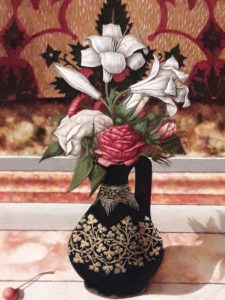
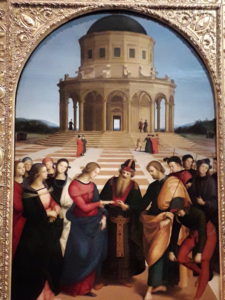
Note the blog title. I am confident that this will not be my only post in 2 years about this fabulous museum, so I’m already giving it a marker to distinguish it from future posts. Jaws should have never had a Jaws 2, but The Godfather did alright with the second movie, didn’t it? Same with Star Wars, right?
Let me start with some history of the art gallery, and then I’ll move to the paintings. The Brera Gallery was officially established in 1809. It became a museum to house the most important works of art from areas conquered by the French armies. Unlike most of the other important museums of Italy, such as the Uffizi, Brera did not start out life as the private collection of a nobleman or prince, but because of a deliberate policy decision. Here’s the fascinating part- many of the paintings were confiscated from churches and convents throughout the Lombardy area by Napoleon and his armies, and these confiscated pieces were then joined by other artwork from throughout the Kingdom of Italy. There are large altarpieces and frescoes taken right out of churches and convents!
Napoleon rose to prominence during the French Revolution in the late 1700’s and dominated large parts of Italy and Europe until his fall in 1815. During this time Napoleon oversaw the defeat of several Italian territories including the old Papal State, along with the suppression of churches and convents across Italy. During this suppression, many religious masterpieces and works of fine art were confiscated and brought to Milan to be housed and publicly displayed at the Pinacoteca. According to descriptions at the Pinacoteca, Napoleon believed that to be considered the ruler (i.e., emperor) of the advanced world, and for Milan to be considered as sophisticated a place as Paris, a museum collection of the finest art available must be established and made available for public viewing. There are over 500 paintings in the museum, with many others stored away. Many depict religious themes from the 14th century forward. Based on the number of paintings depicting the canals of Venice, Napoleon and his armies looted many churches and monasteries in the Venetian area. I want to read more now about Napoleon’s time in Italy (including from when he was overthrown and exiled!). If you have book suggestions, add them in the comments. Of course there is copy of a bronze statue of Napoleon in the square of the Pinacoteca, depicting Napoleon as the god Mars. If you are the emperor, you can be portrayed however you want!

I can’t possibly explain all that I saw- we were there for 3.5 hours and I could have stayed there for days but Kevin was getting cranky and hungry. I like to read all the descriptions associated with the paintings, as most of you would wearily believe, and I would love to study more of the art history. Here are a few bits of information I found fascinating on my first visit (these are generalities and of course these ‘rules’ of painting changed over the ages and throughout the land):
- The church would have the last word in any painting or fresco to be placed in the church or a monastery, even if it was commissioned by a wealthy person (as almost all were). If the church wanted more symbols added, or more priests or saints depicted, the painting had to be redone or touched up. It’s the medieval version of our touchup apps!
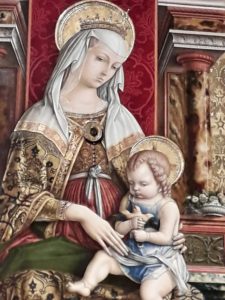
- If the painting or fresco was to be in a public place (like the inside of the church or monastery), there were rules about what needed to be depicted and how. Because many of the common folk did not read or write, there were certain symbols that the church wanted in the painting for consistency’s sake. We’ve all seen the gold halos around the religious figures such as Jesus and Mary, but you can also see certain plants or branches depicted in the paintings which stand for peace or loyalty or piety, etc. Sheep and lamb are present, as Jesus is often referred to as the lamb of God, with Jesus considered the ultimate caregiver/shepherd over the Christian flock. There’s one painting that depicts Mary choosing among many men gathered around her which one will be her husband (with a religious priest or saint behind her, with a steady hand on her shoulder). In the painting you see Joseph with a branch that had a particular leaf growing on it, while the other men held dead sticks. She chose Joseph as her husband!
- There are more depictions of the Last Supper than one could possibly imagine. Depending on the region of the country and the period when the painting was created, you see different food, different types of clothes, and of course in all of them Judas is depicted differently- see the photo below and note the fish which looks very similar to the fish dishes we have seen here. Another portrayal that stood out to me is of Jesus telling the apostles that one of them will betray him, and you see Judas looking out towards the viewer. In the painting Judas has his dog under his feet, with big eyes also looking out at the viewer. Dogs are a symbol of loyalty and the painting makes one feel as if even the dog knew that his master was a traitor. Fascinating depictions of the last supper!~

- Of course, if you paid for the painting, you were often portrayed in the painting itself. A picture tells a thousand words! In one such painting, Francesco Sforza, the Duke of Milan who got his position by usurping the ‘legitimate’ heirs of the Milanese area, is depicted as getting a blessing from baby Jesus. The story goes that this painting was to emphasize his legitimacy as the head of Milan. And check out his children in the bottom of the frame, who look like they were added to the painting as an afterthought.
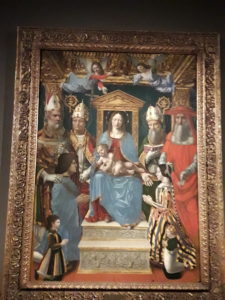
Baby Jesus blessing the Duke of Milan - If you were rich enough and simply wanted a private religious painting placed in a private place (perhaps your own church on your estate, or in an area of your estate reserved for your family’s praying), the rules on what the painting could or could not portray were more lax.

The paintings I have chosen to include here are simply a sampling of some that Kevin and I particularly enjoyed. Look at the food in the still life. 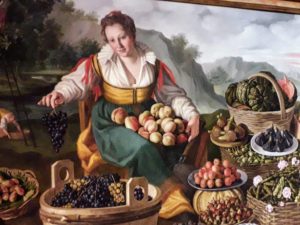
Observe the intricate details portrayed in the painting of Venice.
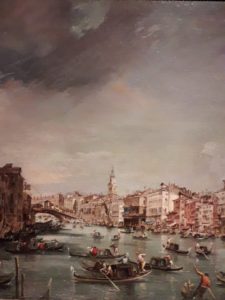
View the landscape of the Lombardy region from 16th century.
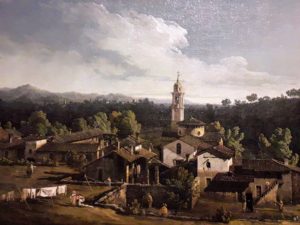
See the painting of Mary with Jesus as a baby, holding an animal with the body of a cat, but the head of a lamb. 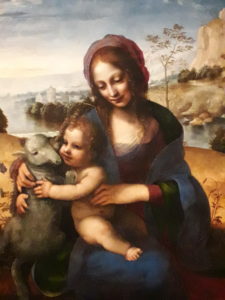
I hope you will visit and enjoy this museum as much as I did. After reading this entry, Kevin said I’m a nerd. True, but he knew that when he married me!